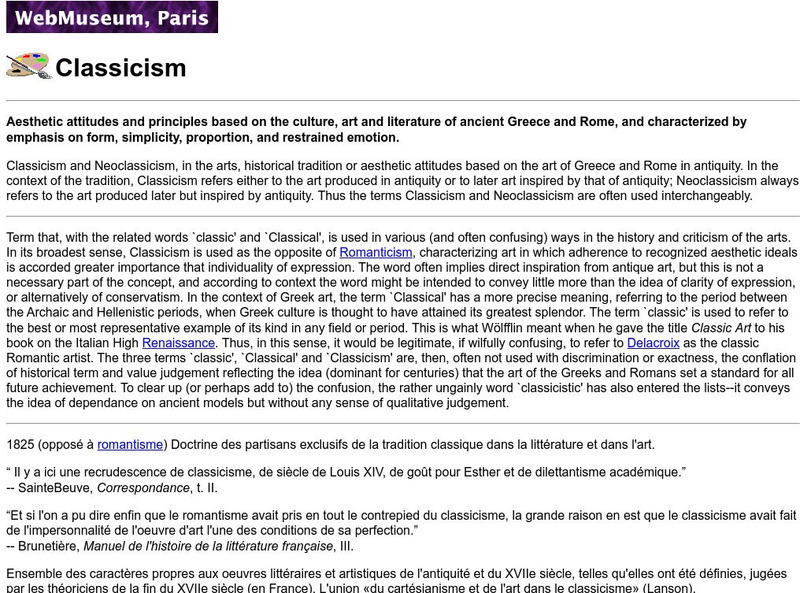Khan Academy
Khan Academy: The Enduring Art of Marble Sculpture
In the 5th century B.C., Greek artists perfected an idealized version of the human form, representing figures with youthful, serene faces and toned bodies in elegant, balanced poses. Painters and sculptors of later centuries were greatly...
Google
Google Maps: Virtual Tour of Pergamon Museum, Berlin
Take a virtual tour through the Pergamon Museum located on Museum Island in Berlin. This world famous museum has life-size, reconstructed monuments from ancient civilizations, including the Pergamon Altar of Zeus, the Roman Market Gate...
Art Institute of Chicago
Art Institute of Chicago: Art Access: Roccoco to Realism
From the early 18th to the mid-19th century, dynamic transformations in European art mirrored turbulent political and social changes, including revolutions, imperial conquests, and the emergence of the modern industrial age....
Other
Parker Middle School: Relief Sculpture
This resource presents a general history and links to everything about relief sculpture. There are image examples and links to Greek, Ancient Roman, Egyptian and Chinese sites.
Khan Academy
Khan Academy: What Is Asia?
"Asia" is a term invented by the Greeks and Romans, and developed by Western geographers to indicate the land mass east of the Ural Mountains and Ural River, together with offshore islands such as Japan and Java. Culturally, no "Asia"...
J. Paul Getty Trust
J. Paul Getty Museum
This world-class American museum exhibits a vast collection of international art. View online exhibitions and explore museum education resources.
Khan Academy
Khan Academy: Polykleitos, Doryphoros (Spear Bearer)
Greek art became popular when Roman generals began conquering Greek cities. This work so impressed the Roman elite that studios were set up to meet the growing demand for copies. The Doryphoros was one of the most sought after, and most...
Australian Broadcasting Corporation
Australian Broadcasting Corporation: Winged Sandals: Athena
A one-page collection of essential facts about Athena, the Greek goddess of wisdom. Includes the name of her Roman equivalent, her family tree, key events in her life, and an audio pronunciation of her name.
Australian Broadcasting Corporation
Australian Broadcasting Corporation: Winged Sandals: Hera
A one-page collection of essential facts about Hera, the jealous wife of Zeus and the goddess of marriage and childbirth. Includes the name of her Roman equivalent, her family tree, key events in her life, and an audio pronunciation of...
Curated OER
Educational Technology Clearinghouse: Clip Art Etc: Accubatio
The act of reclining at meals. The Greeks and Romans were accustomed, in later times, to recline at their meals; but this practice could not have been od great antiquity in Greece, since Homer always describes persons as sitting at their...
Curated OER
Educational Technology Clearinghouse: Clip Art Etc: Cameo
Cameo, a term applied to gems of different colors sculptured in relief. The art of engraving on gems boasts of high antiquity, having been practised with various degrees of success by the Egyptians, Greeks, and Romans.
Curated OER
Educational Technology Clearinghouse: Clip Art Etc: Acinaces
A Persian sword, whence Horace speaks of the Medus acinaces. The acinaces was a short and straight weapon; and thus differed from the Roman sica, which was curved. It was worn on the right side of the body, whereas the Greeks and Romans...
ibiblio
Ibiblio: Web Museum: Classicism
This site gives an overview of classicism, then proceeds to compare it with neoclassicism. The article then explores the roots of the term "classicism" and its inherent meaning to the Greeks and Romans. Contains a French translation.
Princeton University
Princeton University: The Art Museum
The Art Museum at Princeton University has a permanent collection ranging over time from ancient to contemporary and from the Mediterranean to Western Europe, China, Latin America and the U.S. Greek and Roman antiquities and Roman...
Curated OER
Educational Technology Clearinghouse: Clip Art Etc: Sculpture and Coins
The figure in the middle of the following illustration is from a most ancient specimen of Etruscan sculpture, and represents an augur with his lituus, or staff. The others are Roman denarii. - Anthon, 1891
Curated OER
Educational Technology Clearinghouse: Clip Art Etc: Puteal
Puteal, properly means the enclosure surrounding the opening of a well, to protect persons from falling into it. It was either round or square, and seems usually to have been of the height of three or four feet from the ground. It was...
Curated OER
Educational Technology Clearinghouse: Clip Art Etc: Bracae
Trowsers, pantaloons, were common to all the nations which encircled the Greek and Roman population, extending from the Indian to the Atlantic ocean, but were not worn by the Greeks and Romans themselves. Accordingly the monuments...
Curated OER
Educational Technology Clearinghouse: Clip Art Etc: Persona
A mask. Masks were worn by Greek and Roman actors in nearly all dramatic representations. This custom arose undoubtedly from the practice of smearing the face with certain juices and colours, and of appearing in disguise, at the...
Curated OER
Educational Technology Clearinghouse: Clip Art Etc: Persona
A mask. Masks were worn by Greek and Roman actors in nearly all dramatic representations. This custom arose undoubtedly from the practice of smearing the face with certain juices and colours, and of appearing in disguise, at the...
Curated OER
Educational Technology Clearinghouse: Clip Art Etc: Calceus
A shoe or boot, anything adapted to cover and preserve the feet in walking. The use of shoes was by no means universal amount the Greeks and Romans. The Homeric heroes are represented without shoes when armed for battle. Socrates,...
Curated OER
Educational Technology Clearinghouse: Clip Art Etc: Clipeus
The large shield worn by the Greeks and Romans, which was originally of the circular form, and is said to have been first used by Proetus and Acrisius or Argos, and therefore is called clipeus Argolicus, and likened to the sun. But the...
Curated OER
Educational Technology Clearinghouse: Clip Art Etc: Clipeus
The large shield worn by the Greeks and Romans, which was originally of the circular form, and is said to have been first used by Proetus and Acrisius or Argos, and therefore is called clipeus Argolicus, and likened to the sun. But the...
Curated OER
Educational Technology Clearinghouse: Clip Art Etc: Pileus
Any piece of felt; more especially, a skull-cap of felt, a hat. These seems no reason to doubt that felting is a more ancient invention than weaving, not that both of these arts came into Europe from Asia. From the Greeks, who were...
Curated OER
Educational Technology Clearinghouse: Clip Art Etc: Lectica
Lectica was a kind of couch or litter, in which persons, in a lying position, were carried from one place to another. They were used for carrying the dead as well as the living. The Greek lectica consisted of a bed or mattress, and a...










